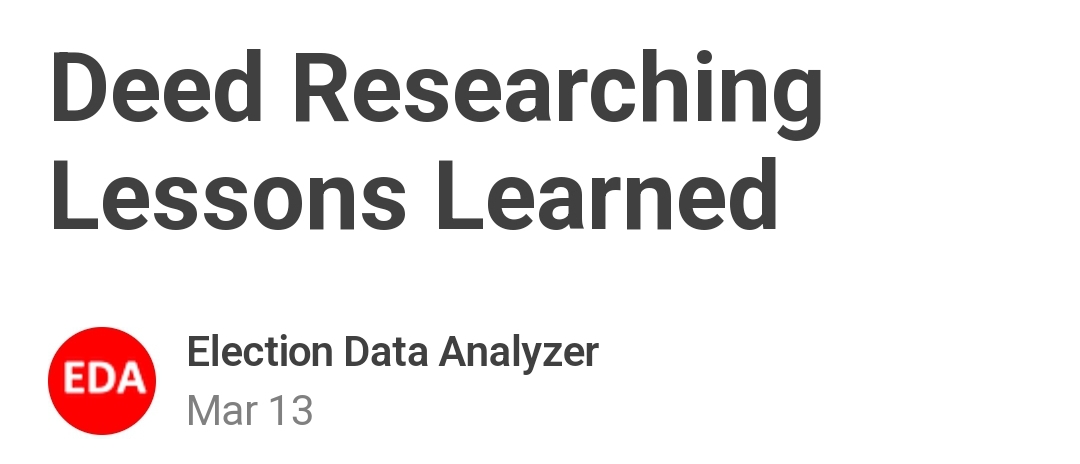I came across this great article for those interested in the subject. It is copied word for word below and a link to the original is provided.
Introduction
The Thaler investigation piqued my interest. Not because I necessarily care about the backgrounds of the attorney’s involved…. I don’t.
I was intrigued by the idea of using the publicly available County Recorder database to look at how our elected officials operate in the real estate market using a “meta data” analysis.
One day I will publish the details of what I have learned. The punch line of that tale will be to show how two very prominent politicians 20+ years ago owned directly adjacent lots when they were “nobody’s” in a very old urban neighborhood, their first homes I would surmise by the young age at the time. Then fast forward 20+ years later and they are both “sElected” in the same year and same state.
It could be a coincidence…..but in a city of millions of residents, what are the chances of that? I am inclined to think that this is “special neighborhood” where up and comers are groomed. But I digress….
Lesson 1
Don’t cast a very wide net. Two people IN THE SAME COUNTY is enough to start with and if they have some common trajectory in their career including geographic proximity and overlapping dates of career “growth”, all the better. The network of individual names involved will quickly grow as you look at related documents.
Lesson 2
Choose people who have more than one real estate transaction. You will be looking for trends amongst the transactions for one person and between people. More data will help you find patterns and trends.
Lesson 3
Once you have identified the people, download the data while it is still publicly available and keep it organized by address and year. If you are lucky, the file name will have encoded in it a date that will make them easy to sort. The data you are looking for are any and all types of Deeds: Trust Deeds, Warranty Deeds, Quit Claim Deeds etc…all of it.
Lesson 4
After you have downloaded the complete history of a property for that person at that address, go backward several transactions so you can see the chain of ownership leading up to the sale of interest. Also, download the transactions after the final sale to see who the parties are involved that purchased the property. This will expand the list of people and firms you are looking at beyond the 2 parties involved.
Lesson 5
Now comes the tedious part. Unless you have technology to scrape data from what will likely be scanned pdf’s, you will need to put together a table, one line per Deed. Common types of columns would be: Doc ID, Prepared By, Lender, Trustee, Borrower (s), Amount, Notary, Deed Type, Notary Info, Address etc. My table ended up being ~ 35 columns wide. Break everything up. Be as granular as possible. Pay attention to all the names and firms and capture it all. This is SUPER tedious.
Lesson 6
Normalize all of your data. This means making sure for example you don’t have “American Title” listed as “Amer. Title” and “Amer. Title Insurance”. They are the same company and it needs to be normalized to the same name for any meta data analysis to work. This goes for all sorts of names, date formats, address etc. Everything has to be normalized.
Lesson 7
When available, capture the Assessor information as well including the subdivision name, plot number, lot number etc. Cross referencing the Recorder and Assessor data is useful.
Lesson 8
Keep hyperlinks embedded in your table for easy access to supporting information. When you are working on a team, this will allow people to check your work as well.
Lesson 9
Look for patterns and trends. There is no easy instruction here other than that. Look for common people, organizations, LLCs. Deeply investigate in particular LLCs and thier proprietors. Open Corporates is a good place for researching companies.
Lesson 10
Put things on a timeline. You can also develop a flow diagram. For my research, I actually had to develop a 3 swim lane diagram for 3 properties because of the interwoven nature of the transactions. Pay attention to WHEN transactions occur. Does it make sense?
Lesson 11
Sometimes there are “Deed Gaps” in your timeline. It doesn’t mean they don’t exist. Just that you need to get creative to find them. For example, if you are looking for a transaction from 20 years ago, start with the current owner and work backwards until the link is found. Also, LLC names are obfuscated often times. You might have “Acme LLC” and “Acme L L C” and “Acme L.L.C.” etc….
Lesson 12
Check for court cases involving related real estate brokers listed on the Deeds. You might find some real “scum bags”. In fact, one of them in my research was a defendant in a pro se RICO case (that was dismissed). Pacer is a good source for court cases.
Lesson 13
Run pivot tables and charts against your normalized data. Items will POP out that you can’t see with the naked eye.
Lesson 14
When all of the above is done, take a step back and look at the narrative and try and make a story out of it. For example:
“ A twenty something couple working as social workers buy’s their first house for cash. Then two years later sells it to an LLC owned by a very powerful attorney.”
Is it legal? Yes
Is it typical? No
Understanding the narrative, not just the facts, and this will help you to ask more questions. I would recommend writing the story in prose.
Lesson 15
While this is public data, be circumspect with the data and any conclusions. Assume nothing is wrong and really question your own bias. Let the data talk to you. Ask for a second and third opinion. If you are not sure of it, keep it to yourself.
Thanks for reading Election Data Analyzer (EDA) Newsletter! Subscribe for free to receive new posts and support my work.
https://electiondataanalyzer.substack.com/p/deed-researching-lessons-learned
Mark Beach




